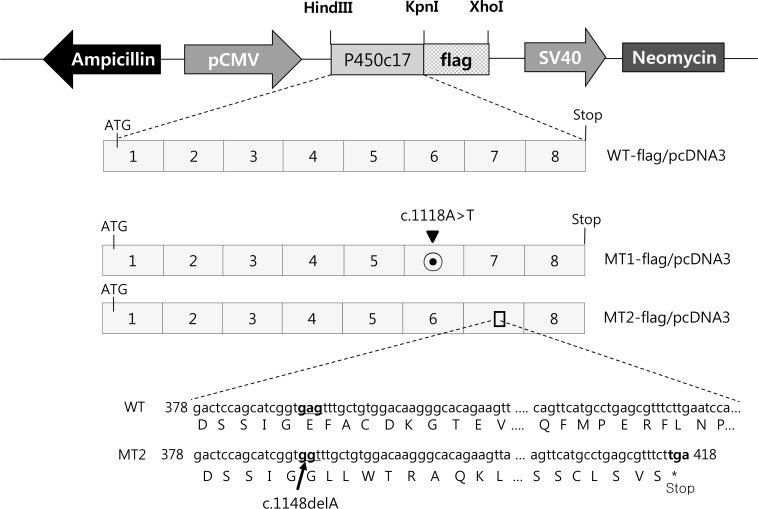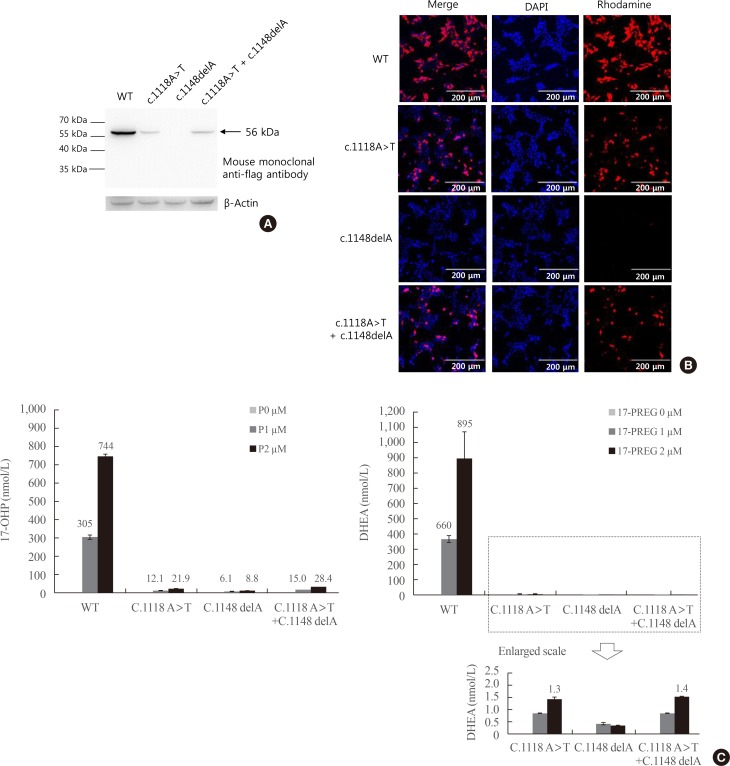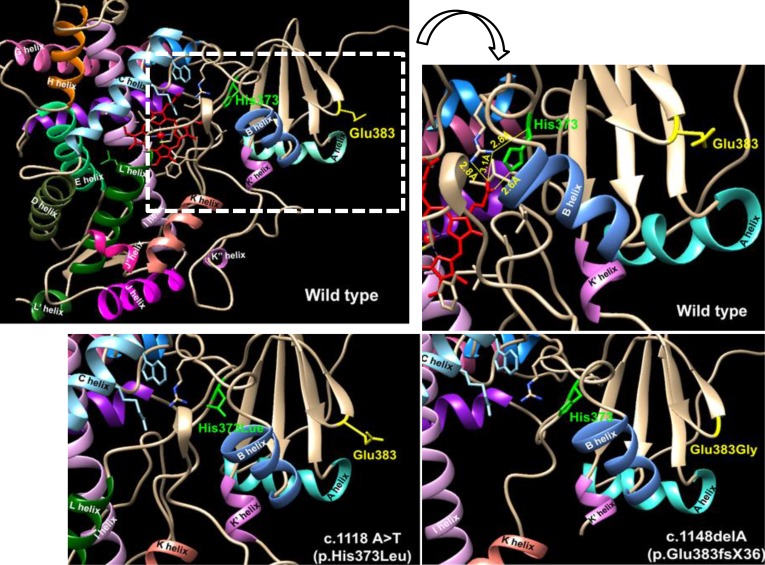1. Zhang M, Sun S, Liu Y, Zhang H, Jiao Y, Wang W, et al. New, recurrent, and prevalent mutations: clinical and molecular characterization of 26 Chinese patients with 17alpha-hydroxylase/17,20-lyase deficiency. J Steroid Biochem Mol Biol. 2015; 150:11–16. PMID:
25697092.

2. Yamaguchi H, Nakazato M, Miyazato M, Toshimori H, Oki S, Shimizu K, et al. Identification of a novel splicing mutation and 1-bp deletion in the 17alpha-hydroxylase gene of Japanese patients with 17alpha-hydroxylase deficiency. Hum Genet. 1998; 102:635–639. PMID:
9703423.
3. Yanase T, Simpson ER, Waterman MR. 17 Alpha-hydroxy-lase/17,20-lyase deficiency: from clinical investigation to molecular definition. Endocr Rev. 1991; 12:91–108. PMID:
2026124.
4. Auchus RJ. Steroid 17-hydroxylase and 17,20-lyase deficiencies, genetic and pharmacologic. J Steroid Biochem Mol Biol. 2017; 165(Pt A):71–78. PMID:
26862015.

5. Jameson JL, De Groot LJ. Endocrinology: adult and pediatric. 7th ed. Philadelphia: Elsevier Saunders;2016. p. 1810–1832.
6. Biglieri EG, Herron MA, Brust N. 17-Hydroxylation deficiency in man. J Clin Invest. 1966; 45:1946–1954. PMID:
4288776.

7. Han B, Liu W, Zuo CL, Zhu H, Li L, Xu C, et al. Identifying a novel mutation of CYP17A1 gene from five Chinese 17α-hydroxylase/17, 20-lyase deficiency patients. Gene. 2013; 516:345–350. PMID:
23291414.

8. Lee ES, Kim M, Moon S, Jekarl DW, Lee S, Kim Y, et al. A new compound heterozygous mutation in the CYP17A1 gene in a female with 17α-hydroxylase/17,20-lyase deficiency. Gynecol Endocrinol. 2013; 29:720–723. PMID:
23772786.
9. Moreira AC, Leal AM, Castro M. Characterization of adrenocorticotropin secretion in a patient with 17 alpha-hydroxylase deficiency. J Clin Endocrinol Metab. 1990; 71:86–91. PMID:
2164530.
10. Heremans GF, Moolenaar AJ, van Gelderen HH. Female phenotype in a male child due to 17-alpha-hydroxylase deficiency. Arch Dis Child. 1976; 51:721–723. PMID:
999330.

11. Gupta MK, Geller DH, Auchus RJ. Pitfalls in characterizing P450c17 mutations associated with isolated 17,20-lyase deficiency. J Clin Endocrinol Metab. 2001; 86:4416–4423. PMID:
11549685.

12. Patocs A, Liko I, Varga I, Gergics P, Boros A, Futo L, et al. Novel mutation of the CYP17 gene in two unrelated patients with combined 17alpha-hydroxylase/17,20-lyase deficiency: demonstration of absent enzyme activity by expressing the mutant CYP17 gene and by three-dimensional modeling. J Steroid Biochem Mol Biol. 2005; 97:257–265. PMID:
16176874.
13. Bao X, Ding H, Xu Y, Cui G, He Y, Yu X, et al. Prevalence of common mutations in the CYP17A1 gene in Chinese Han population. Clin Chim Acta. 2011; 412:1240–1243. PMID:
21420394.

14. Kim YM, Kang M, Choi JH, Lee BH, Kim GH, Ohn JH, et al. A review of the literature on common CYP17A1 mutations in adults with 17-hydroxylase/17,20-lyase deficiency, a case series of such mutations among Koreans and functional characteristics of a novel mutation. Metabolism. 2014; 63:42–49. PMID:
24140098.

15. Tian Q, Yao F, Sha G, Huang S, Tseng H, Schindler AE. Genotyping of a Chinese family with 46,XX and 46,XY 17-hydroxylase deficiency. Gynecol Endocrinol. 2009; 25:485–490. PMID:
19499410.

16. Melmed S, Polonsky KS, Larsen PR, Kronnenberg HM. Williams textbook of endocrinology. 13th ed. Philadelphia: Elsevier Saunders;2016. p. 540–541.
17. Costa-Santos M, Kater CE, Auchus RJ;. Two prevalent CYP17 mutations and genotype-phenotype correlations in 24 Brazilian patients with 17-hydroxylase deficiency. J Clin Endocrinol Metab. 2004; 89:49–60. PMID:
14715827.
18. Geller DH, Auchus RJ, Miller WL. P450c17 mutations R347H and R358Q selectively disrupt 17,20-lyase activity by disrupting interactions with P450 oxidoreductase and cytochrome b5. Mol Endocrinol. 1999; 13:167–175. PMID:
9892022.

19. Okabayashi T, Shima Y, Sumiyoshi T, Kozuki A, Ito S, Ogawa Y, et al. Diagnosis and management of insulinoma. World J Gastroenterol. 2013; 19:829–837. PMID:
23430217.

20. Kater CE, Biglieri EG. Disorders of steroid 17 alpha-hydroxylase deficiency. Endocrinol Metab Clin North Am. 1994; 23:341–357. PMID:
8070426.
21. Geller DH, Auchus RJ, Mendonca BB, Miller WL. The genetic and functional basis of isolated 17,20-lyase deficiency. Nat Genet. 1997; 17:201–205. PMID:
9326943.

22. Sherbet DP, Tiosano D, Kwist KM, Hochberg Z, Auchus RJ. CYP17 mutation E305G causes isolated 17,20-lyase deficiency by selectively altering substrate binding. J Biol Chem. 2003; 278:48563–48569. PMID:
14504283.

23. Tiosano D, Knopf C, Koren I, Levanon N, Hartmann MF, Hochberg Z, et al. Metabolic evidence for impaired 17alpha-hydroxylase activity in a kindred bearing the E305G mutation for isolate 17,20-lyase activity. Eur J Endocrinol. 2008; 158:385–392. PMID:
18299473.
24. Biglieri EG. Mechanisms establishing the mineralocorticoid hormone patterns in the 17 alpha-hydroxylase deficiency syndrome. J Steroid Biochem. 1979; 11(1B):653–657. PMID:
226795.
25. Dean HJ, Shackleton CH, Winter JS. Diagnosis and natural history of 17-hydroxylase deficiency in a newborn male. J Clin Endocrinol Metab. 1984; 59:513–520. PMID:
6086702.

26. Morimoto I, Maeda R, Izumi M, Ishimaru T, Nishimori I, Nagataki S. An autopsy case of 17 alpha-hydroxylase deficiency with malignant hypertension. J Clin Endocrinol Metab. 1983; 56:915–919. PMID:
6300176.
27. Lee MH, Park SW, Yoon TK, Shim SH. Homozygous CYP17A1 mutation (H373L) identified in a 46,XX female with combined 17α-hydroxylase/17,20-lyase deficiency. Gynecol Endocrinol. 2012; 28:573–576. PMID:
22452398.
28. Katsumata N, Ogawa E, Fujiwara I, Fujikura K. Novel CYP17A1 mutation in a Japanese patient with combined 17alpha-hydroxylase/17,20-lyase deficiency. Metabolism. 2010; 59:275–278. PMID:
19793597.
29. Sahakitrungruang T, Tee MK, Speiser PW, Miller WL. Novel P450c17 mutation H373D causing combined 17alpha-hydroxylase/17,20-lyase deficiency. J Clin Endocrinol Metab. 2009; 94:3089–3092. PMID:
19470621.
30. Qiao J, Hu RM, Peng YD, Song HD, Peng YW, Gao GF, et al. A complex heterozygous mutation of His373Leu and Asp487-Ser488-Phe489 deletion in human cytochrome P450c17 causes 17alpha-hydroxylase/17,20-lyase deficiency in three Chinese sisters. Mol Cell Endocrinol. 2003; 201:189–195. PMID:
12706306.
31. Katsumata N, Satoh M, Mikami A, Mikami S, Nagashima-Miyokawa A, Sato N, et al. New compound heterozygous mutation in the CYP17 gene in a 46,XY girl with 17 alpha-hydroxylase/17,20-lyase deficiency. Horm Res. 2001; 55:141–146. PMID:
11549876.
32. Shin DH, Yu SH, Choi YM, Kim JG, Kim SW, Shin CS, et al. Six cases of congenital adrenal hyperplasia that were due to 17alpha-hydroxylase/17,20-lyase deficiency. J Korean Endocr Soc. 2009; 24:109–115.
33. Bee YM, Manju C, Papari-Zareei M, Auchus RJ. Phenotypic variation in a Chinese family with 46,XY and 46,XX 17α-hydroxylase deficiency. Gynecol Endocrinol. 2012; 28:322–325. PMID:
22087567.

34. Ingle RA. Histidine biosynthesis. Arabidopsis Book. 2011; 9:e0141. PMID:
22303266.










 PDF
PDF ePub
ePub Citation
Citation Print
Print



 XML Download
XML Download